Why Local Business Online Marketing Is Your Competitive Edge
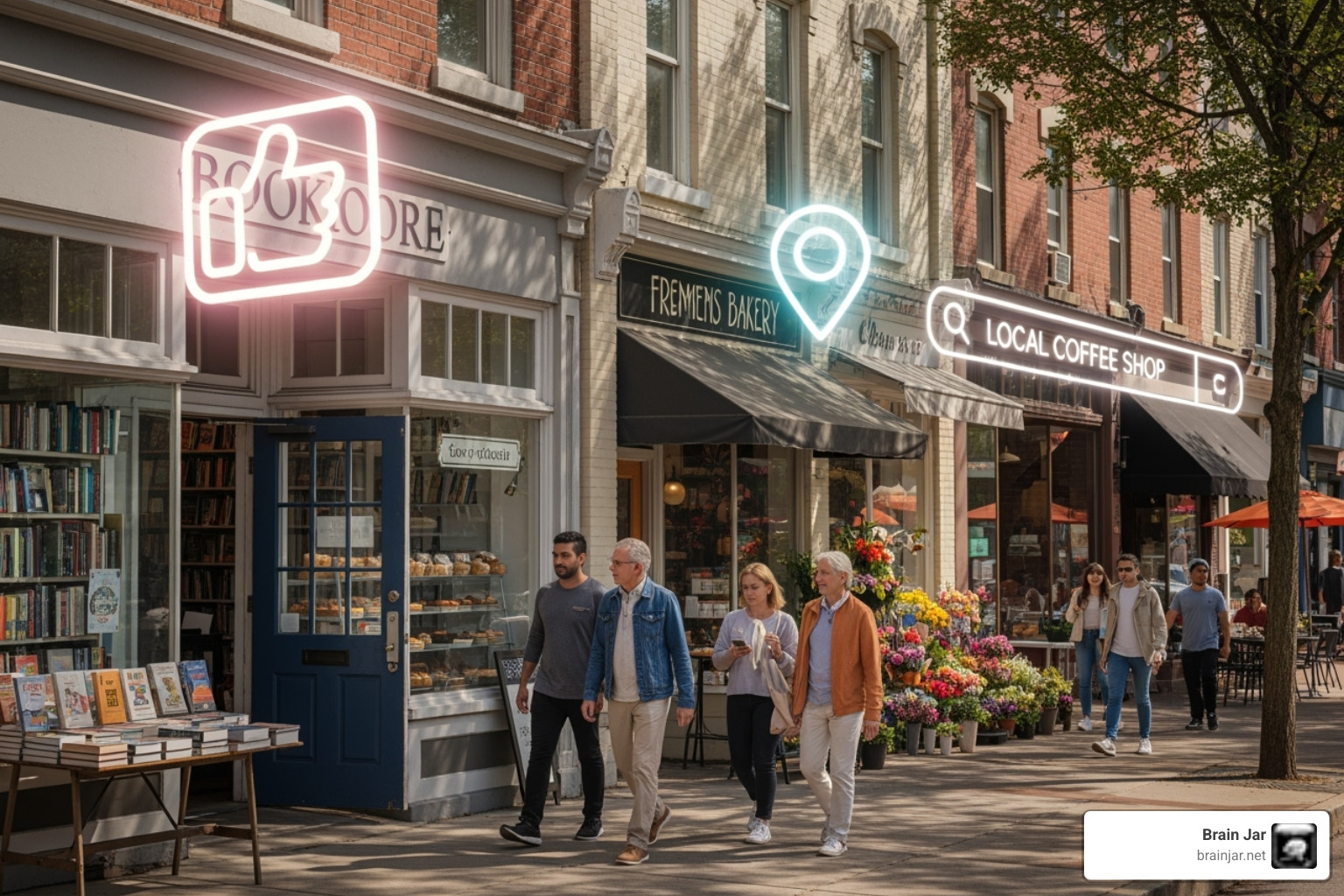
Local business online marketing is the process of promoting your business to nearby customers through digital channels like search engines and social media. It combines location-based strategies to drive foot traffic and phone calls.
Key Components of Local Business Online Marketing:
- Google Business Profile optimization
- Local SEO for “near me” searches
- Online review management
- Geo-targeted advertising
- Local content marketing
- NAP (Name, Address, Phone) consistency
The shift from traditional Yellow Pages to online search has changed how customers find local businesses. Research shows that many local businesses are not online or have struggled with their website marketing, creating massive opportunities for those who get it right.
Local search marketing is critical because it targets customers with high purchase intent. When prospects can’t find you online, you don’t exist to them, and competitors capture that business instead.
I’m HJ Matthews, Business Development Manager at Brain Jar, and I’ve spent over 15 years helping businesses master local business online marketing strategies. Through my own local ventures and work with hundreds of clients, I’ve seen how the right digital approach can transform a business into a community leader.
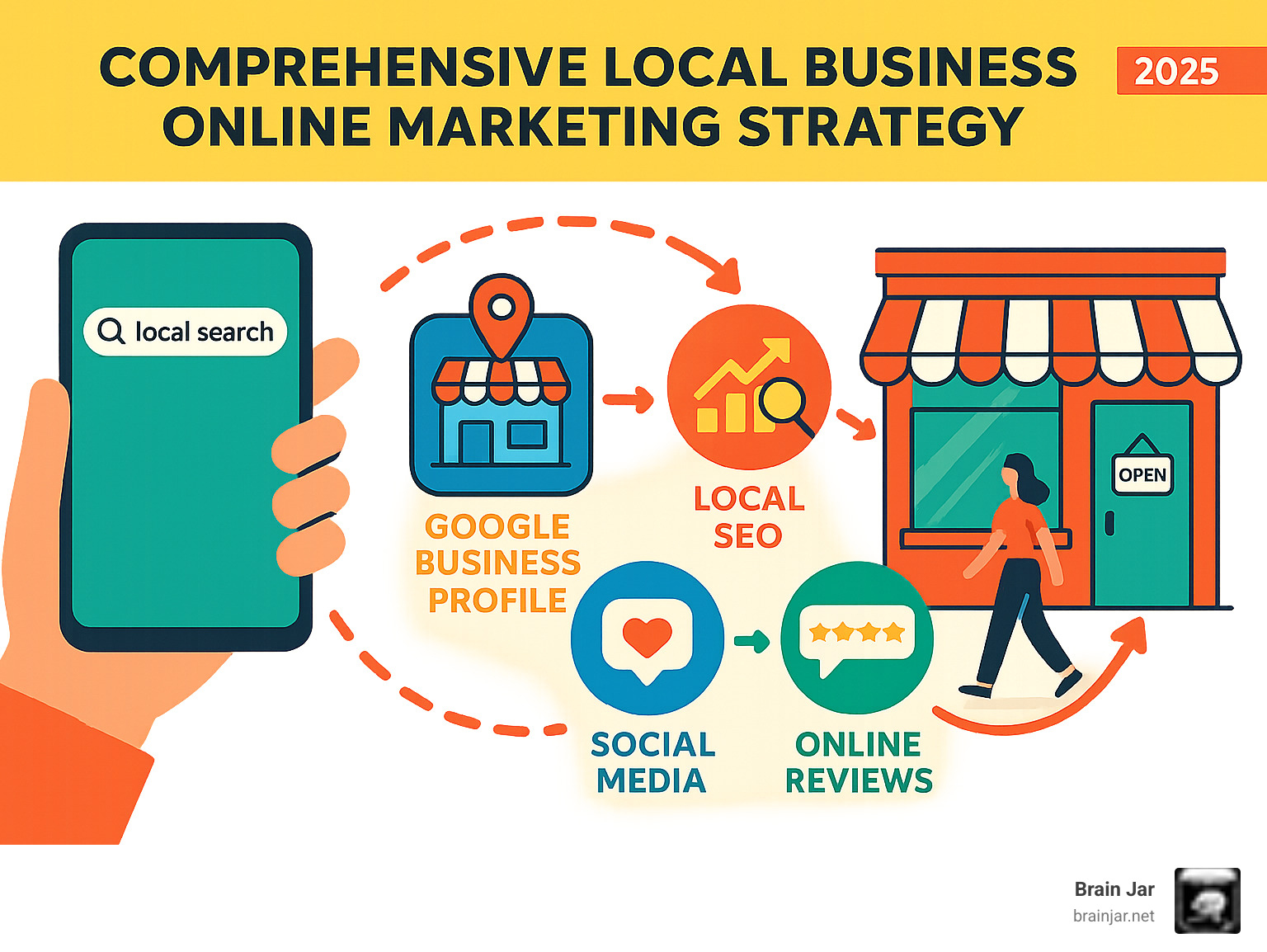
Why This Guide Matters
In today’s digital-first world, the customer journey often begins online with searches like “pizza near me” or “plumber in Riverside CA.” These “near-me” searches are where local business online marketing shines. This guide will empower you with strategies to not just appear in these searches, but to dominate them.
By focusing on local online marketing, you’re not just casting a wide net; you’re using a targeted approach to reach customers who are most likely to walk through your door. It’s about making your business the obvious choice for your neighbors.
1. Nail Your Local SEO Foundation

Imagine your website as your digital storefront. It needs to be optimized for local search engines. This is the cornerstone of local business online marketing. Without a strong foundation, other marketing efforts will struggle.
Local Keyword Research & On-Page Basics
The first step is understanding how local customers search. This means focusing on local intent. A local cafe should target “best coffee Riverside CA” or “coffee shop near me,” not just “best coffee.”
Use tools to find keywords that combine your product/service with your city or neighborhood. For instance, a tax lawyer in Southern California might target “tax lawyer Southern California.”
Once you have your keywords, integrate them naturally into your website:
- Meta Titles and Descriptions: Make them compelling and include your primary local keywords.
- Header Tags (H1, H2, H3): Structure your content and include keyword variations.
- Body Content: Write engaging content that answers local customers’ questions.
- Internal Links: Link relevant pages to help search engines understand your site’s structure.
- Site Speed: A fast-loading website is crucial for user experience and SEO, especially on mobile.
- Schema Markup: Add this structured data to your site’s HTML to help search engines understand your business details, which can lead to rich snippets in search results. See Google’s guidance for Local Business structured data.
- SSL Certificate (HTTPS): An SSL certificate encrypts data, indicating a secure connection. Google considers it a ranking signal and it builds user trust.
Optimizing your website for local SEO is an investment that pays dividends. If you’re looking for support, our SEO Services Gold Plan is designed to tackle these technical aspects, ensuring your digital storefront is polished and prominent.
Mobile & Voice Search Readiness
Mobile-friendliness is a must-have for local business online marketing. Google uses mobile-first indexing, meaning it primarily ranks the mobile version of your site.
Ensure your website performs well on mobile devices by focusing on:
- Core Web Vitals: These Google metrics, called Core Web Vitals, measure user experience, including loading performance, interactivity, and visual stability.
- Touch-Friendly Navigation: Make buttons and links easy to tap on a small screen.
- Fast Load Times: Mobile users are impatient; even a one-second delay can impact conversions.
Voice search is also on the rise, with users asking assistants like Siri and Alexa for local recommendations. These queries are often conversational and hyper-local. To optimize for voice search:
- Use natural, question-based language in your content.
- Focus on long-tail keywords.
- Ensure your Name, Address, and Phone number (NAP) are accurate and consistent, as assistants pull from these listings. For background, see Voice search.
By making your website easy to use on any device, you’re satisfying both Google and your potential customers.
2. Listings & Reviews: Your Digital Storefront
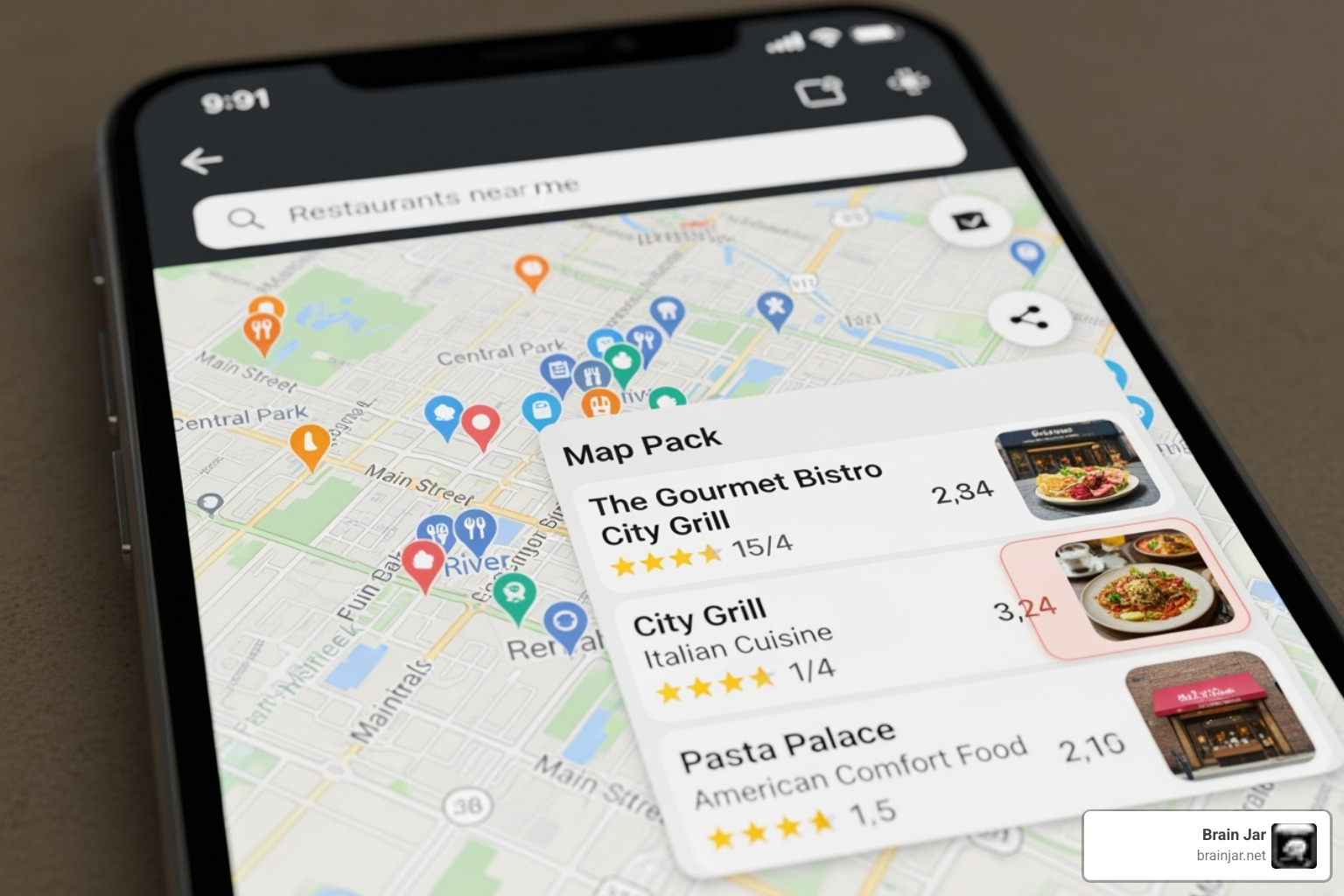
With your website optimized, the next step in local business online marketing is managing your online listings and reviews. These are often a customer’s first impression, so they need to be welcoming and trustworthy.
Claim Your Google Business Profile
Your Google Business Profile (GBP) is your welcome mat on Google Search and Maps. It’s a free and powerful tool that helps Google show your business in relevant local searches.
To make your GBP a magnet for customers, you must first claim and verify your listing (see Google’s instructions to verify your business). Once verified, complete every section of your profile. This gives Google the details it needs to match you with the right searchers.
Key actions include:
- Ensure your Name, Address, and Phone number (NAP) are identical everywhere online for consistency.
- Select the most accurate Business Categories.
- Write a compelling Business Description with relevant keywords.
- Keep your Hours of Operation updated, especially for holidays.
- Upload high-quality Photos and Videos of your business, products, and team.
- Use the Posts feature for updates, offers, and events.
- Answer questions in the Q&A Section and detail your Services/Products.
Beyond Google, list your business on other important online directories like Yelp, Facebook, and Apple Maps. The more consistent your NAP is across these platforms, the better.
Review Strategy to Build Trust
Online reviews are the modern word-of-mouth. A strong collection of positive reviews boosts credibility and attracts new customers. More good Google reviews can also help you rank higher in Maps listings.
To build this trust signal:
- Actively ask for reviews. Encourage happy customers by having staff ask at checkout, sending a follow-up email or text with a direct link, or using QR codes in your store.
- Respond to ALL reviews, both positive and negative. This shows you’re engaged and value customer feedback. Thank positive reviewers. For negative reviews, apologize sincerely and offer to resolve the issue offline. Handling criticism gracefully can build significant trust.
- Monitor reviews regularly across all platforms.
- Showcase your best reviews on your website and social media. This “social proof” is incredibly persuasive.
A steady stream of fresh, positive reviews signals to customers and search engines that your business is active, loved, and focused on its community.
3. Social Media & Content: The Heartbeat of Local Business Online Marketing
Social media is where local business online marketing gets exciting. It’s where local businesses can shine by building genuine relationships with people who live, work, and shop in their neighborhood.
Content marketing works hand-in-hand with your social presence. By consistently sharing valuable content, you position your business as a trusted voice in your community, not just another place to spend money.
Storytelling for Local Business Online Marketing
Every local business has authentic stories that chains can’t replicate. These moments are gold for your marketing.
- Behind-the-scenes content works well. Show your team, your process, or your workspace to build trust.
- Live video is a powerful tool for demonstrating services, answering questions, or just chatting. Its authenticity creates an instant connection.
- Use location tags and local hashtags (e.g., #DowntownRiverside) in every post to help locals find your content.
- Showcase user-generated content. When customers tag you in photos, it’s a powerful endorsement. Always ask for permission before resharing.
- Get involved with community events online and off. Post about local happenings to weave your business into the community’s online conversation.
Managing social media while running a business can be overwhelming. Our Social Media Management Plan can take this off your shoulders, ensuring your community sees engaging content that drives results.
Collaborate with Influencers & Partners
You don’t have to build your online presence alone. Strategic partnerships are a key part of successful local business online marketing.
- Micro-influencers in your area can be valuable partners. These are local people with engaged followings who can introduce your business to potential customers who trust their opinions.
- Co-marketing with complementary businesses creates win-win situations. A coffee shop partnering with a local bookstore, for example, expands everyone’s reach.
- Joint promotions work beautifully. Run a giveaway together, offer mutual discounts, or host a joint event like a workshop or charity fundraiser.
- Sponsorships and community involvement show your commitment to the area. Sponsoring local teams or events builds relationships that translate into loyal customers.
When you collaborate, ask for backlinks to your website. These local links signal to Google that you’re an established part of the community. Building these relationships takes time, but the payoff in search rankings and business growth is worthwhile.
4. Ads & Email: Fast-Track Results for Local Business Online Marketing
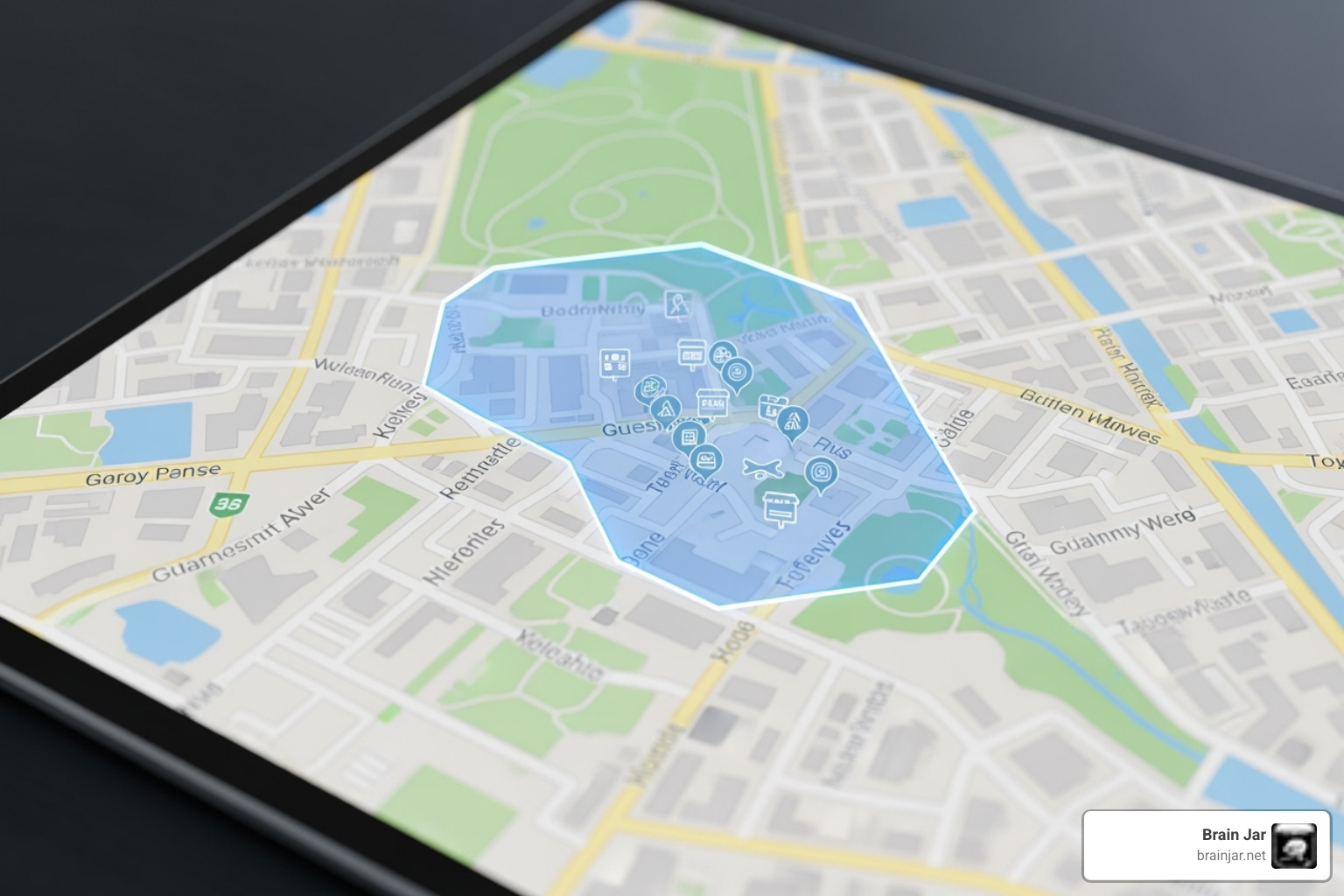
While organic growth is great for the long term, sometimes you need customers now. Paid advertising and email marketing can deliver fast, targeted results for your local business online marketing, helping you reach the right people with precision.
Geo-Targeted PPC & Social Ads
Geo-targeted Pay-Per-Click (PPC) and social media ads let you put your message in front of local customers who are actively looking for your services.
With Google Ads, you can use Radius Targeting to show ads only to users within a specific distance of your business. Bidding on “Near Me” Keywords (e.g., “plumbers near me”) captures people with immediate needs. For service businesses, Local Services Ads (LSAs) appear at the very top of search results, and you only pay when a customer contacts you. For urgent services, Call-Only Ads are designed to generate phone calls instantly.
On social media platforms like Facebook and Instagram, you can use Location-Based Targeting to define your audience by zip code or city. Combine this with Interest and Behavior Targeting to find highly qualified customers. Use Offer Ads to promote deals and events to your local audience. Don’t forget Nextdoor, a neighborhood-focused platform perfect for tapping into local word-of-mouth.
Geo-targeted ads are efficient. You invest in connecting with people who can actually become customers, leading to a much higher Return on Ad Spend (ROAS).
Email Drip Campaigns That Convert Locals
Email marketing is a powerful, cost-effective way to nurture leads and build customer loyalty. For local businesses, it’s about creating personal, community-focused connections.
First, Build Your Local List by gathering emails from in-store sign-ups, your website, and events. Then, Segment your list to send more relevant messages (e.g., new vs. repeat customers).
Offer Incentives for Locals, like exclusive discounts or early access to sales. Feature Local Content in your emails, such as news about your business or community events.
Finally, use Automation (Drip Campaigns). These are pre-written email sequences sent automatically based on triggers:
- Welcome Series: Greet new subscribers and offer a first-time incentive.
- Post-Purchase Follow-up: Thank customers and encourage reviews.
- Re-engagement Campaigns: Entice inactive customers to return with a special offer.
- Event Reminders: Promote local workshops or classes.
Effective email marketing keeps your business top-of-mind. If setting up these sequences seems daunting, our Drip Email Campaign services can help you craft compelling messages that connect with your local customers.
5. Measure Success & Avoid Common Pitfalls
You’ve built your local business online marketing strategy. Now comes the crucial part: measuring what’s working and learning from what isn’t. Tracking your marketing is like checking your car’s dashboard—it tells you if you’re on the right path.
Build a Local Marketing Dashboard
Creating a simple dashboard means focusing on the metrics that matter for a local business. Watch the numbers that connect directly to customers and calls.
- Google Analytics 4 (GA4): Shows where your website visitors are coming from geographically. Are they local?
- Google Business Profile Insights: Tracks how many people viewed your listing, called, or requested directions. Rising numbers are a great sign.
- Google Search Console: Reveals which search terms bring people to your site, helping you focus your content and ad efforts.
- Call Tracking: Use trackable phone numbers on different marketing channels to see which ones generate the most calls.
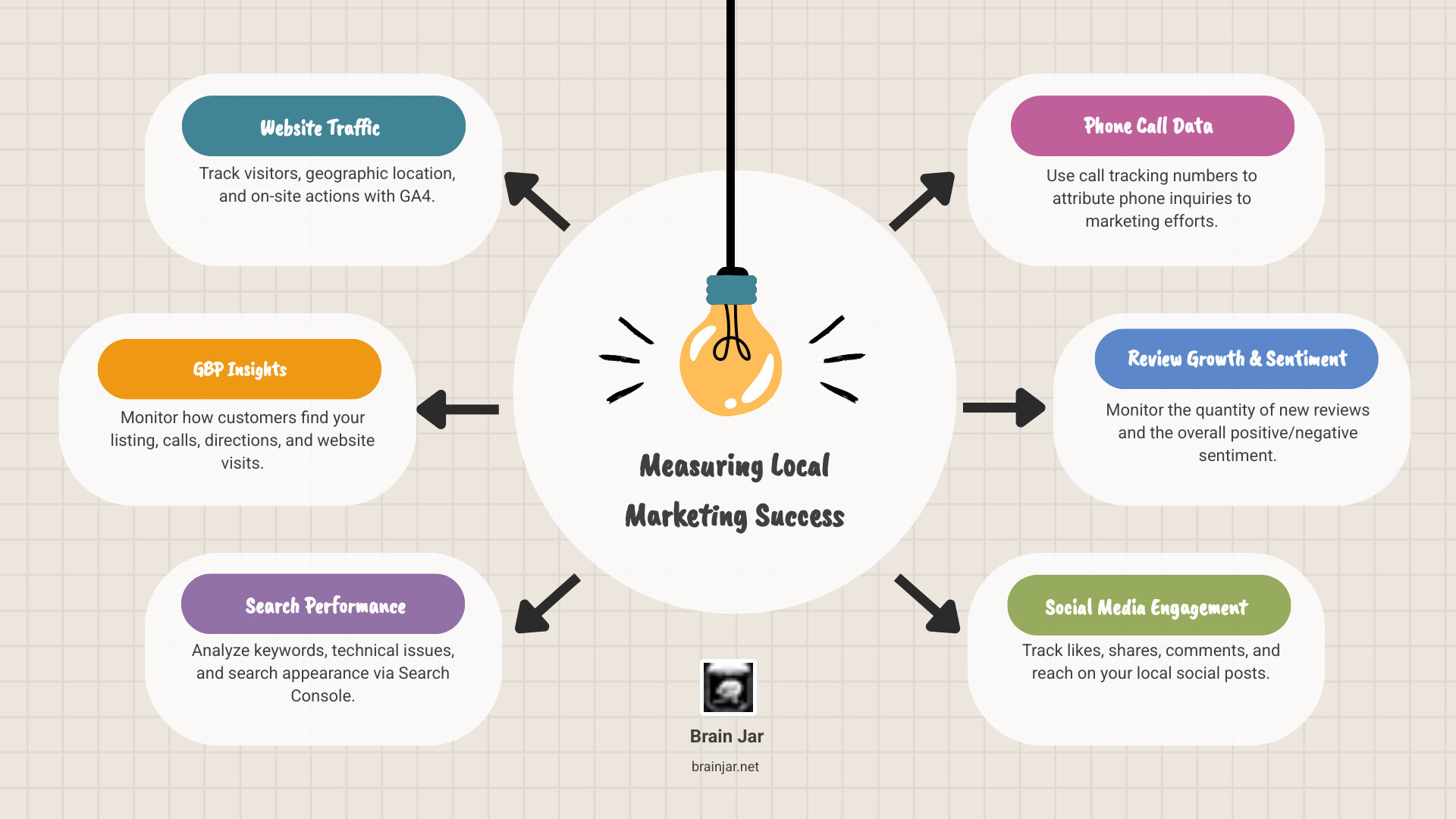
- Review Growth and Sentiment: Keep a pulse on customer satisfaction. A drop in review frequency or a shift to negative feedback signals a problem.
- Foot Traffic: Connect online efforts to in-store visits by asking customers “How did you hear about us?” or using QR codes for special offers.
Review these numbers regularly to spot trends and adjust your strategy before small problems become big ones.
Pitfalls in Local Digital Marketing
Even experienced owners make mistakes that can hurt their local business online marketing efforts. Most are avoidable once you know what to look for.
- NAP Consistency Errors: When your business name, address, or phone number varies online, it confuses Google and can hurt your local rankings. Audit your listings to ensure they match exactly.
- Neglecting Your Google Business Profile: Your GBP needs regular attention. Add fresh photos, create posts, and respond to reviews to keep it active.
- Ignoring Mobile Users: If your website is slow or looks bad on mobile, you’re turning away most potential customers.
- Untargeted Ad Spend: Running ads to people outside your service area wastes money. Always use geo-targeting.
- “Set It and Forget It” Mentality: Local marketing requires consistent effort. Search engines reward businesses that stay active.
- Giving Up Too Quickly: Building local authority takes months, not days. Consistency is key to dominating your local market.
- Overlooking Community Engagement: Be part of your community, don’t just advertise to it. Participate in local discussions and build real relationships.
Sometimes the most effective approach combines digital strategies with grassroots efforts. This integrated approach, often called guerilla marketing, can be incredibly powerful. Our Guerilla Marketing services can help you blend traditional and digital tactics effectively.
Frequently Asked Questions about Local Marketing
We often hear similar questions from local business owners. Let’s tackle some of the most common ones.
What’s the difference between local SEO and general SEO?
General SEO aims to rank a website for broad keywords across the entire internet (e.g., “best coffee”). Local SEO focuses on making a business visible in local search results for a specific geographic area (e.g., “best coffee near me” or “coffee shop in Riverside CA”). Local SEO relies heavily on your Google Business Profile, local citations, and reviews to drive foot traffic or local service calls.
How many reviews do I need to rank in the Map Pack?
There’s no magic number. However, studies show a strong correlation between the number of Google reviews and higher Map Pack rankings. It’s not just about quantity; quality (star rating), recency, and diversity of reviews also matter. The key is to have a consistent strategy for getting new reviews and responding to them. Aim for a continuous flow rather than a specific number.
Can I manage multi-location marketing from one dashboard?
Yes. For businesses with multiple locations, specialized tools and platforms can streamline multi-location marketing. These tools allow you to manage all Google Business Profiles, ensure NAP consistency, monitor reviews, track performance, and run geo-targeted ad campaigns for each branch from a single interface. A centralized dashboard is crucial for maintaining brand consistency and saving time.
Conclusion
Winning online as a local business isn’t about huge budgets; it’s about making smart, steady efforts in the right places.
We’ve covered building a strong foundation with local SEO, the importance of online listings and reviews, using social media to tell your story, and how targeted ads and emails can bring in customers fast.
When you do these things, you’re not just competing. You’re building a loyal local customer base and becoming a trusted part of your community. This is the heart of successful local business online marketing.
The path is clear: be seen, be helpful, and engage with your audience.
Here at Brain Jar, we understand the challenges and opportunities facing local businesses, especially in Southern California. Our team knows web development, SEO, social media, and ad campaigns inside and out. We’re here to help businesses like yours shine.
Ready to take your local business to the next level? Let’s connect. See how our services, like our complete Social Media Management Plan, can help you reach your community and win online.
